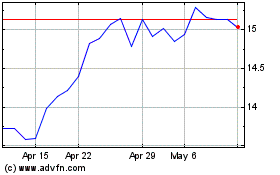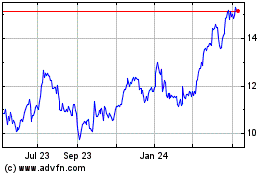By Patricia Kowsmann and Margot Patrick
European banks are using the pandemic to make changes investors
have wanted for years: slash jobs, shut branches and force
customers online.
Germany's second-largest lender, Commerzbank AG, said Thursday
that it would cut a third of its domestic staff and almost half of
its bricks-and-mortar presence after pressure from U.S. shareholder
Cerberus Capital Management. Bank mergers under way in Italy and
Spain are expected to close thousands of overlapping branches.
Business consulting firm Kearney predicts one-quarter of Europe's
165,000 bank branches will be gone in three years.
Banks are one of Europe's economic weak links, and they have
been slow to change. Compared with U.S. peers, European banks
struggle to make enough money to support lending growth. They came
into the Covid-19 crisis still digesting a mountain of bad loans
from the sovereign-debt crisis that started more than a decade
ago.
The pandemic injected urgency into the situation. The European
Central Bank has leaned on banks to reform and has paved the way
for cost-saving mergers. National governments, long resistant to
approving bank mergers that would result in job cuts, have changed
their tune. Dreary stock-market valuations have spurred CEOs to
act.
"The pandemic, to some extent, has been a catalyst for banks to
bite the bullet and start addressing these weaknesses in a more
radical way," Andrea Enria, head of banking supervision at the ECB,
said recently.
European banks' costs are high compared to the revenue they
generate. One area of low-hanging fruit is bank branches. Spain's
top five banks closed 8% of their branches last year, and have
vowed to shut more. Despite years of cuts, the country had one of
the highest number of commercial bank branches per capita in the
eurozone -- 49 for every 100,000 people in 2019 -- according to the
International Monetary Fund, compared with 30 in the U.S.
Caixabank SA, which is buying smaller Bankia SA to scale up,
said it would save EUR770 million a year, the equivalent of $930
million, a large part of which analysts expect to come from
shutting as many as half of its 6,300 branches.
The hope is that the pandemic has taught customers how to live
without frequent trips to bank branches, which are expensive to
maintain and staff.
Anna de Juan, a 60-year-old Bankia customer, used to go to a
branch almost every day for at least an hour to make cash transfers
and manage investment funds for a small asset-holding firm she
works for. Since the pandemic, she has done almost everything
online or over the phone.
"It has been a great change for me; I have saved time and
energy," she said.
Branch foot traffic dropped 30% during the pandemic at Ireland's
AIB Group PLC. That led to an unexpected benefit for the bank.
Over-65s, who have been resistant to using online tools, are now
the fastest-growing group on AIB's digital channels, said CEO Colin
Hunt. He said branches can be an important "shop window." But it is
merging some, cutting back on office space and eliminating 1,500
jobs to cut costs 10%.
So far, investors remain skeptical about whether the newfound
resolve for cutting will be enough. European bank shares have
languished for years. Europe's largest banks, despite having
balance sheets on par with U.S. rivals, trade at a fraction of
their market value.
At Commerzbank, years of slow progress on cost-cutting agitated
its second-largest shareholder, Cerberus. Last summer it demanded a
sharper turnaround, after which the bank's CEO and chairman
resigned. The private-equity giant is sitting on a paper loss of
over EUR300 million from its 2017 investment.
"If we want to make the bank future-proof, we need to carry out
in-depth restructuring, and as quickly as possible," Manfred Knof,
Commerzbank's CEO, said Thursday. The sharp cuts have been
supported by the German government, the bank's largest shareholder,
and have so far faced little resistance from unions.
A person familiar with Cerberus's thinking said the plan, which
includes exiting international locations and unprofitable
operations, is largely in line with what it has long called
for.
In Italy, Intesa Sanpaolo SpA shed 10,000 jobs and hundreds of
branches after it merged with a smaller rival last year. Chief
Executive Carlo Messina said parts of the strategy were "reset due
to the pandemic" as customers moved online, and the combined bank's
annual cost savings rose 37% to EUR700 million.
Even still, Italy's largest bank by assets has more than 4,000
branches, on par with JPMorgan Chase & Co. and Bank of America
Corp., despite operating in a smaller market. Intesa plans to keep
at least 3,000 branches and turn them into advice centers to sell
investments and insurance. It is also channeling customers who
don't want to go online toward drugstores and espresso bars through
a venture with a payments processor.
--Xavier Fontdegloria contributed to this article.
Write to Patricia Kowsmann at patricia.kowsmann@wsj.com and
Margot Patrick at margot.patrick@wsj.com
(END) Dow Jones Newswires
February 14, 2021 05:44 ET (10:44 GMT)
Copyright (c) 2021 Dow Jones & Company, Inc.
Commerzbank (PK) (USOTC:CRZBY)
Historical Stock Chart
From Jan 2025 to Feb 2025

Commerzbank (PK) (USOTC:CRZBY)
Historical Stock Chart
From Feb 2024 to Feb 2025
